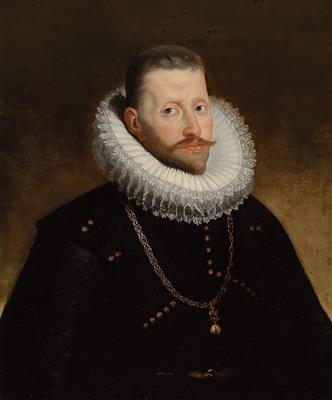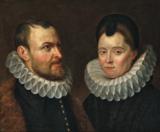Workshop of Peter Paul Rubens

(Siegen 1577–1640 Antwerp)
Portrait of Archduke Albrecht VII of Austria,
oil on canvas, 76.3 x 63.5 cm, framed
Archduke Albrecht was born the fifth son to Emperor Maximilian II and Maria of Spain. He grew up at the Spanish court and pursued an ecclesiastical career at an early age. In 1577 he became archbishop of Toledo and in 1580 the Pope appointed him cardinal. Between 1583 and 1595 he was the viceroy of Portugal and then became governor general of the Spanish Netherlands. When he was engaged to the Spanish Infanta Isabella Clara Eugenia in 1598, the Pope released Albrecht from his duties towards the church. Isabella, a daughter of King Philipp II of Spain and thus a granddaughter of Emperor Charles V, brought the Spanish Netherlands with her as a dowry. The couple resided in Brussels from 1599 onwards. The archduke died there in 1621, and his widow continued to officiate as a regent until her own death in 1633. Both were considered important promoters of the arts and sciences, earning particular merits in this respect as patrons of Peter Paul Rubens.
The archducal couple appointed Rubens as court painter in 1609. Rubens’s primary task was to disseminate the images of the sovereigns in a literal sense and thus promote the state’s official iconography. In September that year, Rubens painted two official portraits of the two sovereigns, showing the couple in splendid costumes against red backdrops. This official type of portrait has come down to us in numerous versions, one of which is now conserved in the Kunsthistorisches Museum in Vienna (see H. Vlieghe, Corpus Rubenianum Ludwig Burchard, vol. 19-2, New York, 1987, pp. 45/46, cat. nos. 68, 69). That Rubens made a second series of portraits in order to produce more current likenesses of the two governors is attested to by a letter from Jan Brueghel the Elder, who was then collaborating with Rubens on the important series of the Five Senses. Scholars believe that the second portrait session resulted in the two canvases now in the Prado, depicting the couple against the backdrops of the Palaces of Tervuren and Mariemont respectively. Further versions of the pair, including the present painting, were painted in Rubens’s lifetime in the master’s workshop. The prototype for this group is documented by a variant of the Prado portraits. It appears in a smaller format and as a single painting showing the archducal couple in identical pose on a Cabinet behind Venus or Juno in Jan Brueghel’s and Rubens’s Allegory of Sight in Madrid (Prado, see fig.1). This proves the existence of the type as early as 1617, the year in which the allegory is dated. In addition to the present painting, further workshop replicas are preserved in the Earl Spencer Collection in Althorp and at the Gemäldegalerie, Dresden (see op. cit. Vlieghe, 1987, pp. 39–41, cat. no. 64).
Esperto: Dr. Alexander Strasoldo
 Dr. Alexander Strasoldo
Dr. Alexander Strasoldo
+43 1 515 60 403
oldmasters@dorotheum.com
22.10.2019 - 17:00
- Prezzo realizzato: **
-
EUR 43.978,-
- Stima:
-
EUR 40.000,- a EUR 60.000,-
Workshop of Peter Paul Rubens
(Siegen 1577–1640 Antwerp)
Portrait of Archduke Albrecht VII of Austria,
oil on canvas, 76.3 x 63.5 cm, framed
Archduke Albrecht was born the fifth son to Emperor Maximilian II and Maria of Spain. He grew up at the Spanish court and pursued an ecclesiastical career at an early age. In 1577 he became archbishop of Toledo and in 1580 the Pope appointed him cardinal. Between 1583 and 1595 he was the viceroy of Portugal and then became governor general of the Spanish Netherlands. When he was engaged to the Spanish Infanta Isabella Clara Eugenia in 1598, the Pope released Albrecht from his duties towards the church. Isabella, a daughter of King Philipp II of Spain and thus a granddaughter of Emperor Charles V, brought the Spanish Netherlands with her as a dowry. The couple resided in Brussels from 1599 onwards. The archduke died there in 1621, and his widow continued to officiate as a regent until her own death in 1633. Both were considered important promoters of the arts and sciences, earning particular merits in this respect as patrons of Peter Paul Rubens.
The archducal couple appointed Rubens as court painter in 1609. Rubens’s primary task was to disseminate the images of the sovereigns in a literal sense and thus promote the state’s official iconography. In September that year, Rubens painted two official portraits of the two sovereigns, showing the couple in splendid costumes against red backdrops. This official type of portrait has come down to us in numerous versions, one of which is now conserved in the Kunsthistorisches Museum in Vienna (see H. Vlieghe, Corpus Rubenianum Ludwig Burchard, vol. 19-2, New York, 1987, pp. 45/46, cat. nos. 68, 69). That Rubens made a second series of portraits in order to produce more current likenesses of the two governors is attested to by a letter from Jan Brueghel the Elder, who was then collaborating with Rubens on the important series of the Five Senses. Scholars believe that the second portrait session resulted in the two canvases now in the Prado, depicting the couple against the backdrops of the Palaces of Tervuren and Mariemont respectively. Further versions of the pair, including the present painting, were painted in Rubens’s lifetime in the master’s workshop. The prototype for this group is documented by a variant of the Prado portraits. It appears in a smaller format and as a single painting showing the archducal couple in identical pose on a Cabinet behind Venus or Juno in Jan Brueghel’s and Rubens’s Allegory of Sight in Madrid (Prado, see fig.1). This proves the existence of the type as early as 1617, the year in which the allegory is dated. In addition to the present painting, further workshop replicas are preserved in the Earl Spencer Collection in Althorp and at the Gemäldegalerie, Dresden (see op. cit. Vlieghe, 1987, pp. 39–41, cat. no. 64).
Esperto: Dr. Alexander Strasoldo
 Dr. Alexander Strasoldo
Dr. Alexander Strasoldo
+43 1 515 60 403
oldmasters@dorotheum.com
|
Hotline dell'acquirente
lun-ven: 10.00 - 17.00
old.masters@dorotheum.at +43 1 515 60 403 |
| Asta: | Dipinti antichi I |
| Tipo d'asta: | Asta in sala |
| Data: | 22.10.2019 - 17:00 |
| Luogo dell'asta: | Wien | Palais Dorotheum |
| Esposizione: | 12.10. - 22.10.2019 |
** Prezzo d'acquisto comprensivo di tassa di vendita e IVA(Paese di consegna Austria)
Non è più possibile effettuare un ordine di acquisto su Internet. L'asta è in preparazione o è già stata eseguita.
Altri oggetti dell'artista
-

Stima:
EUR 10.000,- a EUR 15.000,-
